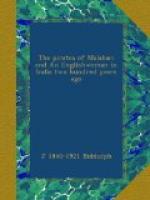[3] Three three-masted ships carrying twenty guns
each; nine two-masted,
carrying from twelve to sixteen
guns; thirteen gallivats, carrying
from six to ten guns; thirty
others unclassed; two on the stocks,
one of them pierced for forty
guns.
* * * * *
AN ENGLISHWOMAN IN INDIA TWO HUNDRED YEARS AGO
On the 9th March, 1709, the Loyall Bliss, East Indiaman, Captain Hudson, left her anchorage in the Downs and sailed for Bengal. As passengers, she carried Captain Gerrard Cooke, his wife, a son and two daughters, together with a few soldiers. For many years Cooke had served the Company at Fort William, as Gunner, an office that included the discharge of many incongruous duties. After a stay in England, he was now returning to Bengal, as engineer, with the rank of captain. The Loyall Bliss was a clumsy sailer, and made slow progress; so that August had come before she left the Cape behind her. Contrary winds and bad weather still detained her, and kept her westward of her course. By the middle of September, the south-west monsoon, on which they depended to carry them up the bay, had ceased to blow, so—
“our people being a great many Downe with the scurvy and our water being short, wee called a Consultation of Officers it being too late to pretend to get bengali the season being come that the N.E. Trade wind being sett in and our people almost every man tainted with distemper,” it was determined to make for Carwar and “endever to gett refresments there.”
On the 7th October, they came to anchor in the little bay formed by the Carwar River. The next day, hearing of a French man-of-war being on the coast, they procured a pilot and anchored again under the guns of the Portuguese fort on the island of Angediva, where lay the bones of some three hundred of the first royal troops ever sent to India. Twenty-six soldiers were sent on shore, ‘most of them not being able to stand.’ The chief of the Company’s factory at Carwar at that time was Mr. John Harvey, who entertained Captain Hudson and all the gentlemen and ladies on board ‘in a splendid manner.’ One may picture to one’s self the pleasure with which they escaped for a time from the ship and its scurvy-stricken crew. To Mr. Harvey and the Company’s officials they were welcome as bringing the latest news from England. They were able to tell of Marlborough’s victory at Oudenarde, and the capture of Lille and Minorca, while Harvey was able to tell them of Captain Kidd’s visit to Carwar twelve years before, and to show them where the freebooter had careened his ship. But Mr. John Harvey found other matter of interest in his visitors. There were few Englishwomen in India in those days, and the unexpected advent of a fresh young English girl aroused his susceptibilities to such an extent that he forgot to report to Bombay




